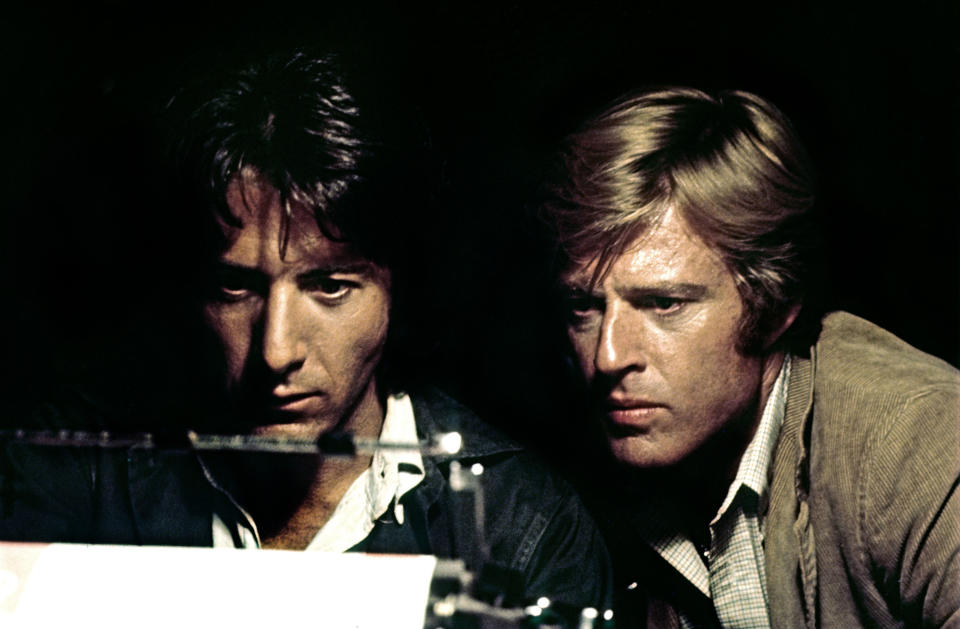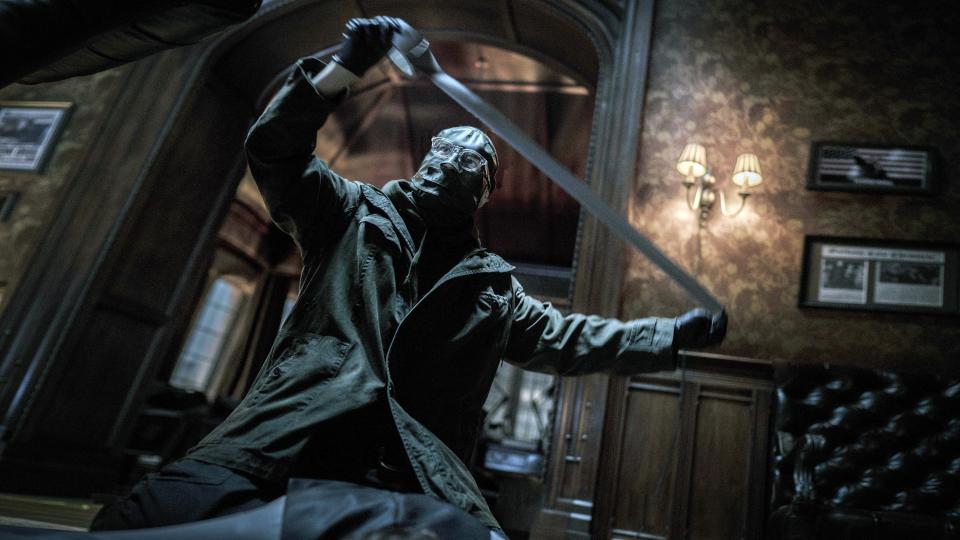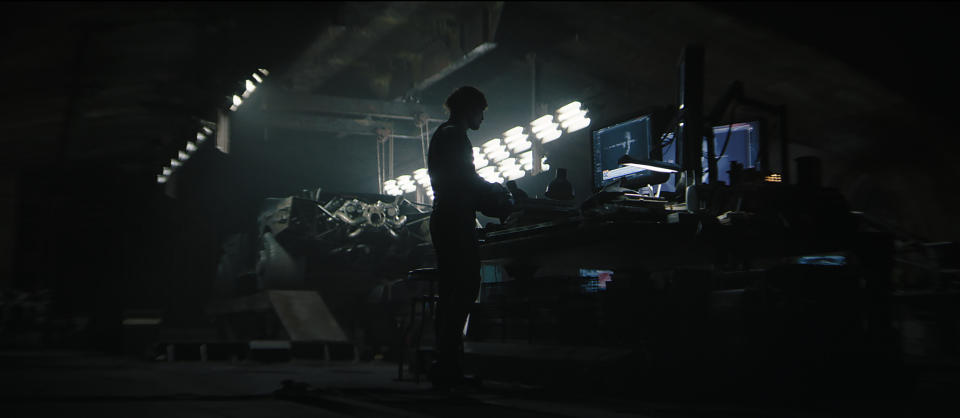How Matt Reeves Made ‘Batman’ His Own, from ‘Chinatown’ to the Batmobile

- Oops!Something went wrong.Please try again later.
- Oops!Something went wrong.Please try again later.
What Matt Reeves initially pitched to Warner Brothers wasn’t a story idea. There was no premise or villain, only an approach. What Reeves promised the studio was he would tell his story in a more emotional and empathetic way than previous Batman films. He would make the story more personal and adapt a more subjective mode of filmmaking, where the audience experienced the film through Batman’s point of view.
The studio knew that Reeves accomplished this empathetic approach to the hero’s journey with the motion-captured gorilla Caesar (Andy Serkis) in Reeves’ two “Planet of the Apes” films. That was enought to make them believe Reeves could be entrusted with its most valuable and beloved piece of IP. But when it came time to time to face the blank page with co-writer Peter Craig, Reeves admits it was more daunting that usual.
More from IndieWire
'The Batman' Deleted Scene Reveals Barry Keoghan's Joker Pitted Against Robert Pattinson -- Watch
Paul Dano Not Done with the Riddler, Writing New Comic for DC
“It’s horrifying because there have been great movies. This is a character that’s been beloved for over 80 years. It’s crazy,” said Reeves when he was guest on IndieWire’s Filmmaker Toolkit. “You’re thinking, ‘Well, I’ve got to show my love for the character, which I have, but also show that there’s something [that] feels like a reason to do another version of the story.”
Reeves settled on two north stars: One was his initial pitch to tell a more personal Batman story, and the other was to focus on the detective side of Batman lore — an element previously explored more in the comics than on screen.
Reeves settled on a question that became his filter: “How can I find a detective story that he’s on that eventually becomes so personal that it isn’t just a detective story, but it’s something that forces him to have an awakening, forces him to change?” He said he “did a deep dive of reading every comic book” and “watched 4 billion noir movies” in search of his Batman.

Courtesy Everett Collection
His search for detective narratives steered Reeves toward the conspiracy-driven films of the 1970s, where each new twist in “Chinatown” and “All the Presidents Men” revealed another layer of corruption. Not only did Reeves see parallels in the news during the Trump administration, it also became the key to unlocking how he’d make the detective story personal.
“Gordon (Jeffrey Wright) and Batman (Robert Pattinson) are like Woodward and Bernstein, the Riddler (Paul Dano) is like the most demented Deep Throat of all time and he’s kind of like talking about how high the corruption goes,” explained Reeves, who named the characters of Colson (a corrupt district attorney, played by Peter Sarsgaard) and Mitchell (the corrupt mayor, played by Rupert Henry-Jones) after the key real-life White House figures in Nixon’s Watergate scandal. Reeves’ idea was that as The Riddler reveals the pervasive corruption, Batman is forced to face some hard truths about his own story.
For narrative structure, the arc of Jake Gittes (Jack Nicholson) in “Chinatown” proved the perfect model. Gittes’ persona of no longer caring, hardened by a back story of his time in Chinatown, parallels Batman’s emotional remove after Bruce Wayne’s parents died. “And yet, as soon as what happens, happens with Evelyn and Hollis Mulwray (Faye Dunaway and Darrel Zwerling), he is compelled to try and save Evelyn in the end because that is what happened to him in Chinatown. It brings all that back.”
Zodiac and Hitchcock: We’re All Guilty

Jonathan Olley / © Warner Bros. / Courtesy Everett Collection
As Reeves and Dano have said in a number of interviews (and the DIY hooded costume makes obvious), The Riddler is based on the real-life Zodiac killer who terrorized the Bay Area decades ago. “It felt like the darkest sort of Rogues Gallery character,” said Reeves. “It seems like the Zodiac may have even been inspired by comics at some point.”
For Reeves, it was more important than anything that The Riddler be Batman’s mirror image. “Bruce has all these resources to build all this and do all this stuff himself, and here’s this guy who, on a budget, does the same,” said Reeves. “And the two of them are haunting echoes of each other in my mind, because they’re both working from a place of vengeance.”
Here, the subjective filmmaking Reeves studied in the films of Alfred Hitchcock came into play. “It all comes from Hitchcock, which is this idea that he makes the audience into a voyeur and implicates them because we all are fascinated with watching, and then there’s a kind of question about the morality of watching,” said Reeves, who starts the film in Riddler’s point-of-view. “Right at the beginning, we are voyeurs with this killer and we are connected to him and I wanted the audience to be implicated in that.”
Reeves went on to explain: “Look, when you go to see a Batman movie, there’s an expectation and a desire to see him unleash on the criminal element. This idea that he is saying that he’s vengeance, and that the audience would enjoy that the way that they did in the teaser trailer, I wanted a movie where that would be the entry point.” Where the Riddler character leads Batman makes the hero question his vengeance, and the audience questions what it once lustfully wanted to see.
Obsession and a DIY Batmobile

Warner Bros.
Reeves said Robert Pattinson, who expressed physical vulnerability and compulsion in the Safdie Brothers’ “Good Time,” embodied a Batman compelled into violent, painful vengeance every night. Ben Affleck’s decision to step away from the role also allowed Reeves to explore a younger version of the character who doesn’t yet have a grasp on his power.
“He’s a loner,” he said. “There’s no Lucius Fox [Bruce Wayne’s business manager, who traditionally supplies the high-tech Batman gear]. He doesn’t have anybody helping him. He’s doing all this like a kind of hobbyist, like a gearhead. He’s got kit car in his garage. The idea was to make a Batmobile that looked like you could have built it yourself if you were totally into cars. All of the gear is stuff he’s been developing on his own, like kind of obsessive tinkerer.”
Reeves broke down how the Batsuit is designed to have scratches, scrapes, and seams: The viewer can see Pattinson’s character made it himself. The car is always “on the edge of control,” giving the sense it might break down at any moment. (Reeves admitted he left out a scene where the Batmobile — for a moment — doesn’t work.) Each of Batman’s wing-suit swoops through the air feels out of control, like Batman might not swing out of his free fall. The director detailed watching GoPro YouTubes with cinematographer Greig Fraser to figure out how they could capture that visceral sense of falling out of the sky with little control.
Reeves wondered aloud if Pattinson’s Batman might, with maturity, learn how to use the Wayne fortune to step up his high-tech gear game. “He might not try to do everything on his own,” said Reeves, before adding, “But part of me thinks he’s just an obsessive.”
The Filmmaker Toolkit podcast is available on Apple Podcasts, Spotify, Overcast, and Stitcher. The music used in this podcast is from the “Marina Abramovic: The Artist Is Present” score, courtesy of composer Nathan Halpern
Best of IndieWire
Sign up for Indiewire's Newsletter. For the latest news, follow us on Facebook, Twitter, and Instagram.


